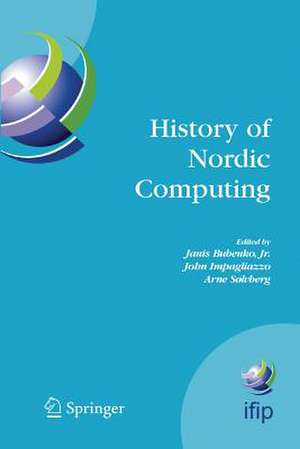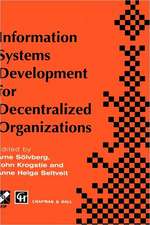History of Nordic Computing: IFIP WG9.7 First Working Conference on the History of Nordic Computing (HiNC1), June 16-18, 2003, Trondheim, Norway: IFIP Advances in Information and Communication Technology, cartea 174
Editat de Janis Bubenko, John Impagliazzo, Arne Soelvbergen Limba Engleză Paperback – 21 noi 2014
| Toate formatele și edițiile | Preț | Express |
|---|---|---|
| Paperback (1) | 614.50 lei 38-44 zile | |
| Springer Us – 21 noi 2014 | 614.50 lei 38-44 zile | |
| Hardback (1) | 664.11 lei 6-8 săpt. | |
| Springer Us – 14 ian 2005 | 664.11 lei 6-8 săpt. |
Din seria IFIP Advances in Information and Communication Technology
- 20%
 Preț: 170.51 lei
Preț: 170.51 lei - 20%
 Preț: 615.74 lei
Preț: 615.74 lei - 20%
 Preț: 340.32 lei
Preț: 340.32 lei -
 Preț: 397.38 lei
Preț: 397.38 lei - 20%
 Preț: 336.02 lei
Preț: 336.02 lei - 20%
 Preț: 340.98 lei
Preț: 340.98 lei - 20%
 Preț: 503.41 lei
Preț: 503.41 lei - 17%
 Preț: 523.40 lei
Preț: 523.40 lei - 20%
 Preț: 502.06 lei
Preț: 502.06 lei - 17%
 Preț: 488.96 lei
Preț: 488.96 lei - 20%
 Preț: 501.04 lei
Preț: 501.04 lei - 20%
 Preț: 403.20 lei
Preț: 403.20 lei - 15%
 Preț: 708.83 lei
Preț: 708.83 lei - 20%
 Preț: 1162.12 lei
Preț: 1162.12 lei - 20%
 Preț: 1288.25 lei
Preț: 1288.25 lei - 18%
 Preț: 1227.21 lei
Preț: 1227.21 lei - 20%
 Preț: 1282.00 lei
Preț: 1282.00 lei - 18%
 Preț: 1224.18 lei
Preț: 1224.18 lei - 18%
 Preț: 953.03 lei
Preț: 953.03 lei - 18%
 Preț: 953.20 lei
Preț: 953.20 lei - 18%
 Preț: 944.99 lei
Preț: 944.99 lei - 18%
 Preț: 948.29 lei
Preț: 948.29 lei - 15%
 Preț: 645.47 lei
Preț: 645.47 lei - 18%
 Preț: 960.13 lei
Preț: 960.13 lei - 20%
 Preț: 1288.11 lei
Preț: 1288.11 lei - 20%
 Preț: 998.70 lei
Preț: 998.70 lei - 18%
 Preț: 949.23 lei
Preț: 949.23 lei - 20%
 Preț: 1283.81 lei
Preț: 1283.81 lei - 20%
 Preț: 995.89 lei
Preț: 995.89 lei - 15%
 Preț: 645.79 lei
Preț: 645.79 lei - 20%
 Preț: 1276.74 lei
Preț: 1276.74 lei - 20%
 Preț: 1922.99 lei
Preț: 1922.99 lei - 20%
 Preț: 1285.97 lei
Preț: 1285.97 lei - 18%
 Preț: 956.69 lei
Preț: 956.69 lei - 18%
 Preț: 946.72 lei
Preț: 946.72 lei - 18%
 Preț: 1224.36 lei
Preț: 1224.36 lei - 20%
 Preț: 1277.89 lei
Preț: 1277.89 lei - 18%
 Preț: 953.03 lei
Preț: 953.03 lei - 18%
 Preț: 947.98 lei
Preț: 947.98 lei - 20%
 Preț: 1292.54 lei
Preț: 1292.54 lei - 18%
 Preț: 956.18 lei
Preț: 956.18 lei - 20%
 Preț: 645.79 lei
Preț: 645.79 lei - 18%
 Preț: 1235.25 lei
Preț: 1235.25 lei - 20%
 Preț: 1284.47 lei
Preț: 1284.47 lei - 18%
 Preț: 1231.01 lei
Preț: 1231.01 lei - 20%
 Preț: 993.09 lei
Preț: 993.09 lei - 20%
 Preț: 1288.94 lei
Preț: 1288.94 lei - 20%
 Preț: 987.17 lei
Preț: 987.17 lei - 18%
 Preț: 1833.33 lei
Preț: 1833.33 lei
Preț: 614.50 lei
Preț vechi: 768.13 lei
-20% Nou
Puncte Express: 922
Preț estimativ în valută:
117.60€ • 121.74$ • 99.40£
117.60€ • 121.74$ • 99.40£
Carte tipărită la comandă
Livrare economică 01-07 martie
Preluare comenzi: 021 569.72.76
Specificații
ISBN-13: 9781461498896
ISBN-10: 1461498899
Pagini: 512
Ilustrații: XIX, 488 p.
Dimensiuni: 155 x 235 x 27 mm
Greutate: 0.71 kg
Ediția:2005
Editura: Springer Us
Colecția Springer
Seria IFIP Advances in Information and Communication Technology
Locul publicării:New York, NY, United States
ISBN-10: 1461498899
Pagini: 512
Ilustrații: XIX, 488 p.
Dimensiuni: 155 x 235 x 27 mm
Greutate: 0.71 kg
Ediția:2005
Editura: Springer Us
Colecția Springer
Seria IFIP Advances in Information and Communication Technology
Locul publicării:New York, NY, United States
Public țintă
ResearchCuprins
Reflections, Thoughts, and Episodes.- An Interview with Börje Langefors.- The Pioneer Era in Norwegian Scientific Computing (1948–1962).- The Role of IBM in Starting up Computing in the Nordic Countries.- Computerisation of the Icelandic State and Municipalities.- Technology transfer, Modernization, and the Welfare State.- A Failure Revisited: The First Finnish Computer Construction Project.- On the Politics of Failure.- Birth of Computer Science Education and Research in Finland.- The Advent of the First General-Purpose Computer in Iceland.- Early Curricula in Computer Science at the University of Iceland.- Research and Curricula Development at Norwegian Universities.- Introducing Information Technology at Norwegian Regional Colleges.- Nordic Cooperation within the Field of Computing.- Cooperation as a Driving Force in Nordic It.- History of the Nordic Computer Industry.- The Datasaab Flexible Central Processing Unit.- of Computers in Norwegian School Mathematics.- From Programming to System Design.- The Birth of It in Upper Secondary Education in Norway.- It for Learning: A Need for a New Approach?.- The Early Nordic Software Effort.- Algol-Genius.- The Birth of Simula.- Club Activity in the Early Phases of Microcomputing in Finland.- MIPROC.- From Binary Strings to Visual Programming.- Ferranti Mercury at the Norwegian Defence Research Establishment.- Making Computing Available.- Scip: A Scandinavian Project on Systems Analysis and Design.- Is Scandinavian Information System Development Becoming Passé?.- Significant Applications.- Applications and Technologies for Maritime and Offshore Industries.- Applications and Technologies for Maritime and Offshore Industries.- Nordunet: The Roots of Nordic Networking.- Where Were the Women?.- When Computers Became of Interest in Politics.- Development in the Growth Base of the ‘Oulu Phenomenon’.- The Norwegian Computing Center and the Univac 1107 (1963–1970).- The Wegematic 1000 Computing Center,1959–1964.- Concluding Remarks.
Textul de pe ultima copertă
International Federation for Information Processing
The IFIP series publishes state-of-the-art results in the sciences and technologies of information and communication. The scope of the series includes: foundations of computer science; software theory and practice; education; computer applications in technology; communication systems; systems modeling and optimization; information systems; computers and society; computer systems technology; security and protection in information processing systems; artificial intelligence; and human-computer interaction. Proceedings and post-proceedings of referred international conferences in computer science and interdisciplinary fields are featured. These results often precede journal publication and represent the most current research. The principal aim of the IFIP series is to encourage education and the dissemination and exchange of information about all aspects of computing.
For more information about the 300 other books in the IFIP series, please visit www.springeronline.com.
For more information about IFIP, please visit www.ifip.or.at.
The IFIP series publishes state-of-the-art results in the sciences and technologies of information and communication. The scope of the series includes: foundations of computer science; software theory and practice; education; computer applications in technology; communication systems; systems modeling and optimization; information systems; computers and society; computer systems technology; security and protection in information processing systems; artificial intelligence; and human-computer interaction. Proceedings and post-proceedings of referred international conferences in computer science and interdisciplinary fields are featured. These results often precede journal publication and represent the most current research. The principal aim of the IFIP series is to encourage education and the dissemination and exchange of information about all aspects of computing.
For more information about the 300 other books in the IFIP series, please visit www.springeronline.com.
For more information about IFIP, please visit www.ifip.or.at.
Caracteristici
Presents a valuable segment of computing history Current books on historical computing do not include such a comprehensive discourse on the evolution of technology from this unique geographic perspective Includes supplementary material: sn.pub/extras




















